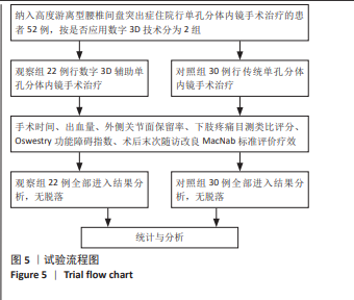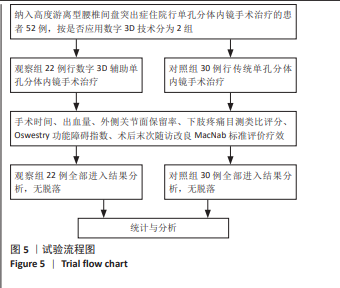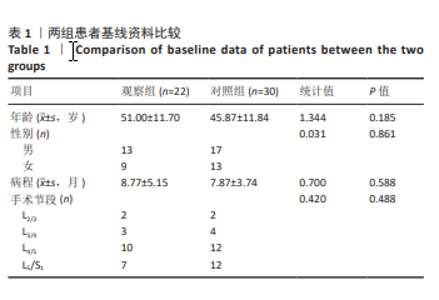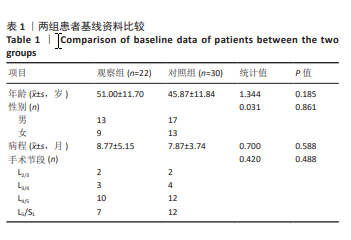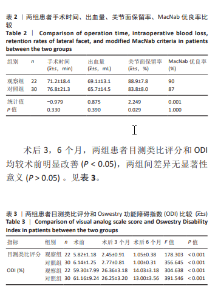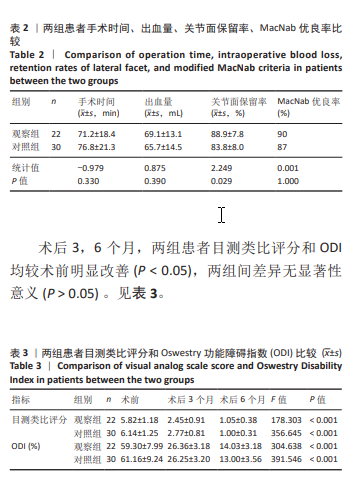[1] SHEPARD N, CHO W. Recurrent Lumbar Disc Herniation: A Review. Global Spine J. 2019;9(2):202-209.
[2] BENZAKOUR T, IGOUMENOU V, MAVROGENIS AF, et al. Current concepts for lumbar disc herniation. Int Orthop. 2019;43(4):841-851.
[3] 杨青志,毛碧峰.腰椎间盘突出症的治疗进展[J].实用中医内科杂志,2023,37(6):66-70.
[4] DIVI SN, MAKANJI HS, KEPLER CK, et al. Does the Size or Location of Lumbar Disc Herniation Predict the Need for Operative Treatment? Global Spine J. 2022;12(2):237-243.
[5] CAI H, LIU C, LIN H, et al. Full-endoscopic foraminoplasty for highly down-migrated lumbar disc herniation. BMC Musculoskelet Disord. 2022;23(1):303.
[6] ZHAO XB, MA HJ, GENG B, et al. Percutaneous Endoscopic Unilateral Laminotomy and Bilateral Decompression for Lumbar Spinal Stenosis. Orthop Surg. 2021;13(2):641-650.
[7] CHEN C, SUN X, LIU J, et al. Targeted fully endoscopic visualized laminar trepanning approach under local anaesthesia for resection of highly migrated lumbar disc herniation. Int Orthop. 2022;46(7):1627-1636.
[8] CHEN CM, LIN GX, SHARMA S, et al.Suprapedicular Retrocorporeal Technique of Transforaminal Full-Endoscopic Lumbar Discectomy for Highly Downward-Migrated Disc Herniation. World Neurosurg. 2020;143:e631-e639.
[9] CHENG W, GAO W, ZHU C, et al. Contralateral translaminar endoscopic approach for highly down-migrated lumbar disc herniation using percutaneous biportal endoscopic surgery : Original research. BMC Surg. 2024;24(1):58.
[10] 谭哲. 三种脊柱后路内镜技术治疗游离型腰椎间盘突出症优缺点比较分析[D].长春:吉林大学,2024.
[11] ITO Z, SHIBAYAMA M, NAKAMURA S, et al. Clinical comparison of unilateral biportal endoscopic laminectomy versus microendoscopic laminectomy for single-level laminectomy: A singlecenter, retrospective analysis. World Neurosurg. 2021;148: e581-e588.
[12] 韩铁鹏,虞攀峰,黄鹏.经皮脊柱内镜对比椎间盘镜治疗腰椎间盘突出症疗效的荟萃分析[J].中国疼痛医学杂志,2023,29(6): 463-470.
[13] 赵晓明,刘亮,袁启令,等.椎间孔镜与椎间盘镜治疗腰椎间盘突出症后复发率及翻修率比较的Meta分析[J].中国内镜杂志,2019, 25(12):1-8.
[14] ZHAO XM, YUAN QL, LIU L, et al. Is it possible to replace microendoscopic discectomy with percutaneous transforaminal discectomy for treatment of lumbar disc herniation? A meta-analysis based on recurrence and revision rate. J Korean Neurosurg Soc. 2020;63(4):477-486.
[15] 单孔分体内镜技术治疗腰椎管狭窄症专家共识[J].实用骨科杂志, 2024,30(3):193-198.
[16] KIM JS, PARK CW, YEUNG YK, et al.Unilateral bi-portal endoscopic decompression via the contralateral approach in asymmetric spinal stenosis:a technical note. Asian Spine J. 2021;15(5):688-700.
[17] 谭芳,张锋,韩帅,等.单孔分体内镜治疗腰椎管狭窄症的临床疗效分析[J/OL].中国修复重建外科杂志:1-5[2024-03-18].
[18] AHN Y, KIM JE, YOO BR, et al. A New Grading System for Migrated Lumbar Disc Herniation on Sagittal Magnetic Resonance Imaging: An Agreement Study. J Clin Med. 2022;11(7):1750.
[19] 孙浩,李晨,聂广龙,等.单侧双通道内镜下腰椎融合术与微创经椎间孔入路椎间融合术治疗腰椎退行性疾病临床疗效比较的Meta分析[J].中国脊柱脊髓杂志,2024,34(4):389-401.
[20] 王彬,何鹏,武振方,等.单侧双通道内镜手术与显微内镜手术治疗腰椎管狭窄症的Meta分析[J].中国脊柱脊髓杂志,2021,31(8): 719-730.
[21] 李丽梅,刘晓东,刘婷婷,等.CT引导下低温等离子射频消融术治疗颈源性胸痛的近期疗效[J].中国疼痛医学杂志,2024,30(2): 137-142.
[22] LEWANDROWSKI KU. “Outside-in” technique, clinical results, and indications with transforaminal lumbar endoscopic surgery: a retrospective study on 220 patients on applied radiographic classification of foraminal spinal stenosis. Int J Spine Surg. 2014;8:26.
[23] LEE CW, YOON KJ. Technical Considerations in Endoscopic Lumbar Decompression. World Neurosurg. 2021;145:663-669.
[24] LEWANDROWSKI KU, TELFEIAN AE, HELLINGER S, et al. Difficulties, Challenges, and the Learning Curve of Avoiding Complications in Lumbar Endoscopic Spine Surgery. Int J Spine Surg. 2021;15(suppl 3): S21-S37.
[25] BALAIN B, BHACHU DS, GADKARI A, et al. 2nd and 3rd generation full endoscopic lumbar spine surgery: clinical safety and learning curve. Eur Spine J. 2023;32(8):2796-2804.
[26] HUANG K, CHEN G, LU S, et al. Early Clinical Outcomes of Percutaneous Endoscopic Lumbar Discectomy for L4-5 Highly Down-Migrated Disc Herniation: Interlaminar Approach Versus Transforaminal Approach. World Neurosurg. 2021;146:e413-e418.
[27] ZENG ZL, ZHU R, WU YC, et al. Effect of Graded Facetectomy on Lumbar Biomechanics. J Healthc Eng. 2017;2017:7981513.
[28] MRAJA HM, KAYA O, MAMMADOV T, et al. Anterior-to-Posterior Epidural Migration of a Lumbar Disc Herniation at L1-L2: A Case Report. Cureus. 2022;14(8):e27568.
[29] 唐永超,刘腾,郭惠智,等.全脊柱内镜下经椎板打孔髓核摘除术治疗重度向上移位型腰椎间盘突出症的疗效分析[J].中国脊柱脊髓杂志,2023,33(2):185-188.
[30] GACEK E, BERMEL EA, ELLINGSON AM, et al. Through-thickness regional variation in the mechanical characteristics of the lumbar facet capsular ligament. Biomech Model Mechanobiol. 2021;20(4): 1445-1457.
[31] LENG Y, TANG C, HE B, et al. Correlation between the spinopelvic type and morphological characteristics of lumbar facet joints in degenerative lumbar spondylolisthesis. J Neurosurg Spine. 2022; 38(4):425-435.
[32] 李兰,殷小丹,李旭雪,等.基于CT观察退变性腰椎滑脱症与关节突关节角及关节椎弓根角的关系[J].河北医学,2024,30(2):290-296.
[33] ZAREI V, DHUME RY, ELLINGSON AM, et al. Multiscale modelling of the human lumbar facet capsular ligament: analysing spinal motion from the joint to the neurons. J R Soc Interface. 2018;15(148):20180550.
[34] 赵勇,李玉茂,李平生,等.单侧小关节分级切除对腰椎稳定性影响的三维有限元分析[J].实用骨科杂志,2009,15(10):764-767.
[35] 余洋,谢一舟,石银,等.三维有限元法分析腰椎不同尺寸关节突成形后相关节段的生物力学特征[J].中国组织工程研究,2021, 25(33):5288-5293.
[36] 赵庆华,王于治,张珂,等.单节段腰椎退行性疾病MIS-TLIF术后上位关节突关节损伤的临床分析[J].中国骨与关节损伤杂志, 2022,37(3):238-241.
[37] WAGUIA KOUAM R, TABARESTANI TQ, SYKES DAW, et al. How dimensions can guide surgical planning and training: a systematic review of Kambin’s triangle. Neurosurg Focus. 2023;54(1):E6.
[38] SOUSA JM, SERRANO A, NAVE A, et al. Transforaminal Endoscopic Approach to L5S1: Imaging Characterization of the Lower Lumbar Spine and Pelvis for Surgical Planning. World Neurosurg. 2023;175:e809-e817.
[39] TAPPA K, BIRD JE, ARRIBAS EM, et al. Multimodality Imaging for 3D Printing and Surgical Rehearsal in Complex Spine Surgery. Radiographics. 2024;44(3):e230116.
[40] DING H, HAI Y, ZHOU L, et al. Clinical Application of Personalized Digital Surgical Planning and Precise Execution for Severe and Complex Adult Spinal Deformity Correction Utilizing 3D Printing Techniques. J Pers Med. 2023;13(4):602.
[41] 毕经纬,任佳彬,刘鑫,等.3D-CT指导单侧双通道内镜下定位L_5、S_1神经根及椎间隙[J].中国组织工程研究,2022,26(33): 5283-5289.
[42] 李鹏,李想,马琳,等.3D打印技术辅助全脊柱内镜精准开窗髓核摘除术治疗高度游离型腰椎间盘突出症的疗效观察[J].中国骨与关节损伤杂志,2023,38(1):25-29. |
